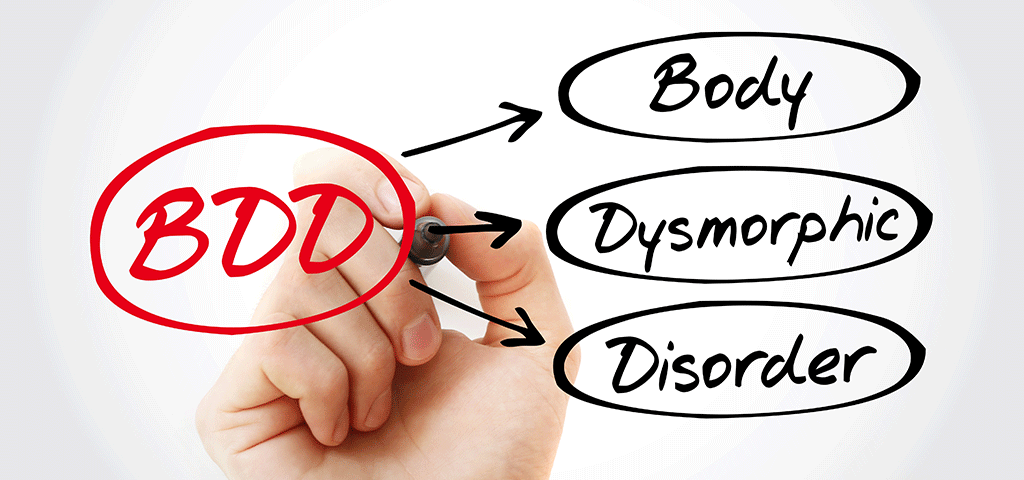Body dysmorphic disorder (BDD), or body dysmorphia, is a mental health disorder where a person spends a lot of time worrying and picking at their physical appearance, particularly their perceived flaws. BDD can occur in people of any age, but it’s most common in teenagers and young adults. The disorder can affect all genders, as well. As with other mental health disorders, little is understood about BDD, which is why our Philadelphia eating disorder clinic is dispelling some common myths about body dysmorphic disorder.
Understanding Body Dysmorphic Disorder (BDD)
People with body dysmorphic disorder can’t stop thinking about one or more perceived defects or flaws in their appearance. Oftentimes, these are flaws that are very minor or can’t be seen by others. Regardless, these individuals may feel embarrassed, ashamed, and anxious to the point where they may avoid social situations.
When you have body dysmorphic disorder, you intensely focus on your appearance and body image, repeatedly checking the mirror, grooming, or seeking reassurance from others about how you look. Your perceived flaws, along with these repetitive behaviors, can be disruptive and cause significant distress, often to the point where your ability to function is impacted.
You may also seek out numerous cosmetic procedures to “fix” your perceived flaws. Afterward, you may feel a temporary satisfaction, which is usually followed by a resurgence of anxiety. This could lead you to search for more ways to fix these perceived flaws, contributing to a continuous, unhealthy cycle.
What Are Common Myths About Body Dysmorphia?
Body dysmorphic disorder can impact a person’s life drastically. Many mental health disorders are riddled with myths and misunderstandings, and BDD is no exception. Nowadays, the media is flooded with body dysmorphia myths, starting with the many celebrities with body dysmorphic disorder who have been portrayed as eccentric and dysfunctional.
To some extent, this portrayal, along with the many other unrealistic body expectations set by the media, has fed into the mischaracterization of the condition rather than educating the public about the disorder. Fortunately, the latter has been the goal more recently.
As more accurate information about body dysmorphic disorder is shared and awareness is brought to the condition, people with BDD can feel less isolated and talk more freely about their experiences. This can greatly contribute to a better understanding and more compassion for those suffering from body dysmorphia. With this in mind, below are some common myths about body dysmorphic disorder and corresponding facts.
1. Myth: Body dysmorphia is an eating disorder.
Fact: Body dysmorphia is not an eating disorder.
While body dysmorphia is not the same thing as an eating disorder, dissatisfaction with one’s body or appearance often contributes to eating disorders. However, these perceptions don’t always have the same outcomes. Eating disorders are not just about a focus on physical appearance but also on using food to have control over one’s life.
Someone with an eating disorder will also have concerns related to the ingestion of food and concern about weight, whereas a person with BDD can be focused on a perceived flaw that isn’t related to weight or eating. Eating disorders and body dysmorphic disorder often co-occur, as there’s often a perception that a person must restrict their diet or engage in other food-based behaviors to meet a goal, but the two diagnoses can exist independently.
2. Myth: BDD is about vanity.
Fact: Body dysmorphic disorder is not about vanity but quite the opposite.
Vanity is defined as extreme self-pride and admiration. People with BDD are often so self-critical about their perceived physical flaws that it can prevent them from carrying out their daily life. Those afflicted with this condition are often convinced that everyone else also sees their flaws and is as focused on them as they are. This can lead to a great deal of distress and self-consciousness.
People with BDD may also sometimes resort to extremes to “fix” a perceived flaw. Some of these behaviors can include seeking out plastic surgery or trying to repair the issue through behavioral methods like skin picking or using makeup. People may misinterpret this extreme focus on physical appearance as vanity, but in truth, body dysmorphia and vanity are on two opposite ends of the spectrum.
3. Myth: Body dysmorphic disorder dissipates in adulthood.
Fact: Body dysmorphia can affect people of all ages.
One of the most common body dysmorphic disorder myths is that the condition only occurs in teens, young girls, and/or women. However, this disorder can occur in people of all ages, including the elderly population. One study showed that BDD did decrease in many adults over the age of 44, but this doesn’t mean the condition is dissipated for all adults.1
Often, older and elderly adults with BDD continue to struggle with this condition, after which it morphs into other areas of their lives. As older people struggle with BDD, the aging process can also trigger self-criticism and self-consciousness. Adults with body dysmorphic disorder often avoid talking to their medical provider about these issues due to a fear of seeming irrational or vain, which could prevent them from getting the help they need.
4. Myth: BDD isn’t a serious disorder.
Fact: Body dysmorphic disorder is a serious condition that can lead to detrimental effects.
There are also myths about BDD related to the severity of this disorder. For starters, BDD can have a severe impact on a person’s self-esteem, to the extent that they’re at risk of developing depression or anxiety. Additionally, the significant level of self-consciousness related to the disorder can lead to avoidance of others, resulting in isolation.
The severity of the condition depends on the individual circumstances, particularly those who experience the condition before the age of 18. One study on BDD patients from 2001 to 2003 showed that out of 200 people, 78% experienced suicidal ideation, and 27.5% had made a suicide attempt.2 While this may seem like a benign condition to those who aren’t entirely familiar with it, BDD can lead to mental illness, eating disorders, and various other problems.
Help for Body Dysmorphia
Body dysmorphic disorder can be a difficult condition to cope with. It can lead to a variety of problems if the individual doesn’t receive therapy and support. If you or someone you care about is struggling with body dysmorphia, our facility can help.
Banyan Treatment Centers offers body dysmorphia treatment that utilizes evidence-based therapies to teach clients how to cope with their symptoms and understand their disorders. We also offer Philadelphia eating disorder treatment for individuals who have developed anorexia nervosa, bulimia nervosa, or others.
For more information about our eating disorder programs, call Banyan Philadelphia today at 888-280-4763 or send us your contact information.
Sources:
- Cambridge - The Prevalence of Body Dysmorphic Disorder in the United States Adult Population
- The Journal of Clinical Psychiatry - Suicidal ideation and suicide attempts in body dysmorphic disorder.
Related Reading:









